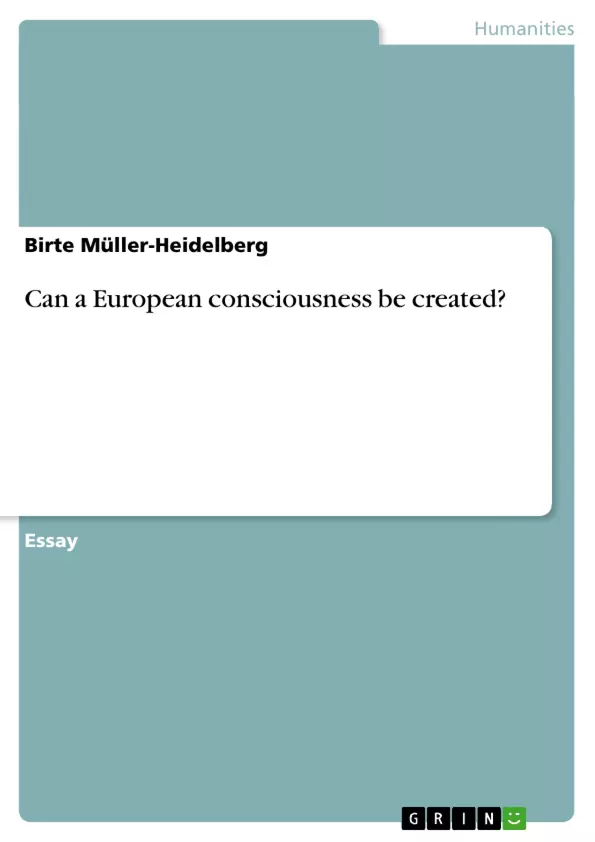Italians only eat pasta; all Swedish girls look gorgeous and the Germans only listen to folk
music. These stereotypes do not specify whole nations but still paint pictures people can
identify with. “The European” picture does not exist yet – neither on a culinary, nor on an
aesthetic or musical basis. To get on with the European idea, a European Identity is inevitable.
Without it, integration will never work to a satisfying extent and Europe cannot become the
much-quoted “ever closer Union”. Only with a common identity will people be willing to
stand up for each other and only with such an identity will the European Parliament and the
Commission be fully legitimised. The first step into that direction is the creation of a
European Consciousness, the idea to make people think of Europe as much as they think of
their respective nationality. This essay will therefore analyse the concept of a European
Identity and then break it down to the first steps to be taken – the idea of a European
Consciousness.
Chapter 2 will first define the term of identity and then sketch the specific problems that arise
in Europe where so many different identities are already established. It then draws up the
image of a possible long-term identity for the citizens of the Union’s member states. Chapter
3 examines the process of setting this identity up, taking a closer look at several different
agents that could help to speed up the process. Finally the conclusion summarizes the chances
for a European Consciousness leading to a legitimising identity.
Inhaltsverzeichnis (Table of Contents)
- Introduction
- A European Identity
- The term of identity
- Specific problems for a collective identity in Europe
- The model of a European Identity
- The creation of a European Identity
- Politics
- Institutions
- Schools
- Media
- Conclusion
Zielsetzung und Themenschwerpunkte (Objectives and Key Themes)
This essay explores the concept of a European Identity and analyzes the potential for creating a European Consciousness. It examines the challenges and opportunities of fostering a sense of shared identity among diverse European nations, aiming to determine whether a collective European identity is attainable.
- Defining the term of identity and its significance for the European Union.
- Analyzing the specific problems of establishing a collective European identity within a diverse continent.
- Exploring the potential for a European Identity and its key features.
- Examining the processes and agents involved in the creation of a European Identity.
- Assessing the prospects of a European Consciousness leading to a legitimizing identity.
Zusammenfassung der Kapitel (Chapter Summaries)
Chapter 2: A European Identity
This chapter delves into the concept of identity, examining its meaning and importance for the European Union. It highlights the challenges of forging a common identity amidst existing national identities, while exploring the potential for a long-term European Identity. The chapter analyzes the three key features of identity – inclusion and exclusion, creating traditions, and a spatial referent – within the context of Europe.
Chapter 3: The creation of a European Identity
Chapter 3 explores the process of establishing a European Identity, focusing on various agents that could contribute to its development. It examines the roles of politics, institutions, schools, and media in shaping a collective European consciousness. The chapter discusses how these agents can contribute to a shared sense of belonging among Europeans.
Schlüsselwörter (Keywords)
The essay focuses on the key terms and concepts of European Identity, including collective identity, national identity, European consciousness, inclusion and exclusion, tradition, spatial referent, legitimacy, and constructivism. It explores the challenges and opportunities of fostering a sense of shared identity in a diverse and multicultural European Union.
- Quote paper
- Birte Müller-Heidelberg (Author), 2003, Can a European consciousness be created?, Munich, GRIN Verlag, https://www.grin.com/document/19650



